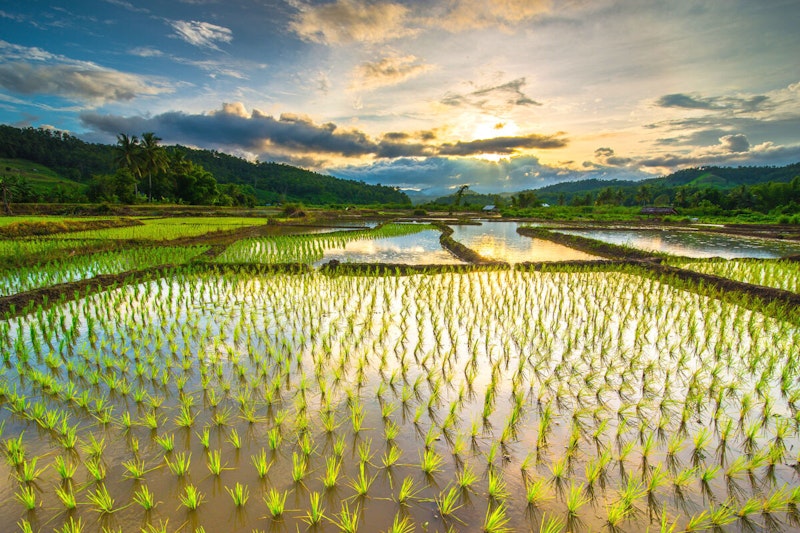Study Notes
GCSE Geography | Increasing Food Supply (Resource Management - Food 4)
- Level:
- GCSE
- Board:
- AQA, Edexcel, OCR, Eduqas
Last updated 25 May 2024
There are lots of different strategies that we can use to increase food security - some of these are relatively cheap low-tech solutions, whereas others are extremely expensive and rely on complex technology.
Irrigation
Irrigation is simply the artificial watering of crops to maintain production when the water supply is low or unreliable, taking water from rivers, lakes or reservoirs. Large-scale irrigation is widely used across HICs and also in some parts of Asia where monsoon rains are able to recharge supplies of water, however it is not used as much most LICs as the technology needed is expensive, evaporation can be a big issue and it often leads to over-abstraction of water sources which can't recover. An example of this is Lake Chad, which was once the sixth largest lake in the world, but has decreased by more than 90% in area over the last 40 years after being used for irrigation. Farmers across LICs are more likely to rely on smaller systems.
Types of irrigation
- large-scale schemes - involving dams to control the flow of water, reservoirs to store water, and a network of canals and pipes to transfer water to where it is needed
- flood irrigation - controlled flooding of fields which involves water from rivers or wells being pumped along canals which are controlled by small dams; this is used widely in rice paddies across Asia
- Sprinkler systems - where water is piped to a central point in a field to sprinkler to water crops; these are used in fields in HICs and can be moved around to ensure even coverage of crops
- Drip irrigation - water travels through pipes with lots of tiny holes spread out across crops so water can be delivered straight to the roots before it can be evaporated
Pros and cons
- Increases crop yields and therefore income – increases food security
- Large-scale systems are expensive to set up and can lead to over-abstraction, which means there is less water for other users, and can lead to the drying out of lakes in the long-term
- Can lead to waterlogging of soil through inadequate drainage, or salinisation (the build-up of salts)

Aeroponics and hydroponics
These are modern techniques of farming that don't require soil.
Aeroponics
Aeroponics uses air rather than soil to grow plants - the plants are usually suspended in a greenhouse with a fine mist of nutrients and water sprayed directly onto the roots and lower stem every few minutes. Plants grown using aeroponics tend to grow quickly as their roots receive much more oxygen than they would if they were planted in soil, and there is no risk of the plant roots rotting due to the lack of direct contact with soil and water.
Hydroponics
Hydroponics are grown in water rather than soil, with the roots submerged into nutrient-rich water. This eliminates the risk of any diseases associated with soil but also means that crops such as lettuce can be shipped alive in water, which maintains their freshness.
Pros and cons of both systems
- Because water and nutrients are delivered directly to the plant, this kind of food production can be very efficient and enable crops to grow quickly and year-round in-doors
- They also need less space to grow (can be stacked up) and can be moved around easily
- But they are expensive to set up and run (they require a lot of heat and light), and the equipment can easily breakdown
- They also need a lot technical expertise regarding the equipment, but also the exact mix of nutrients needed

Biotechnology
Biotechnology is the genetic modification of plants and animals e.g. injecting the genes from one plant to another. Most commonly this is used to make plants that are resistant to drought, pests and diseases, so are there is less chance of crop failure, and also resistant to herbicides, meaning the farmer can spray weed killer onto a crop without harming the crop itself. Plants have also been genetically modified to increase their nutrient content, through increasing their levels of vitamins or proteins, to increase shelf life and to improve flavour.
Biotechnology has also been used in livestock farming, for example scientists have been able to remove the section of DNA that leaves pigs vulnerable to porcine reproductive and respiratory syndrome, which costs farmers more than £1.5 billion a year in losses across Europe, and have developed an extra gene for chickens which disrupts the transmission of avian flu.
Genetically modified organisms are very controversial so they are still not widely used to increase food supply in Europe, although they are commonly used in the USA.
Pros and cons
- Most modifications are to make plants resistant to pests and diseases to increase food security
- Plants can also be modified to have more vitamins or proteins, to have a better flavour, or to have a longer shelf life
- They can also be modified to be grown in poor conditions, e.g. in a drought, so therefore will increase food security
- But, many people are concerned about possible knock-on impacts on the environment and human health.
- The pollen from GM crops is spread the same as any other plants so there is concern about contamination - gene flow/genetic pollution, as well as concerns about pesticide resistance

Green Revolution
Biotechnology has played a big role in the Asian Green Revolution which refers to the period in the 1960s when scientists started to develop new strains of higher yielding seeds for grains, such as rice and wheat (high-yielding varieties - HYVs). These were very successful and saw yields increase by 40% in India and Bangladesh, increasing food security. At the same time scientists developed new chemical fertilisers, herbicides and pesticides to increase food production further, which was essential at a time of rapid population growth in South-east Asia.
Today there is a similar green revolution focusing on addressing the issue of rapid population growth and food security in Africa.
Pros and cons
- Increases yield and some crops can better withstand drought
- Today the focus is on sustainable farming, such as conserving biodiversity (preserving drought-resistant strains or ‘crop wild relatives’), protecting soil and water source, and ensuring the well-being of local communities
- But some of the new techniques are expensive

Appropriate technology
Appropriate technology (also known as immediate technology) involves low-tech projects that are cheap and managed by the local community, e.g. drip irrigation schemes. This is in contrast to many aid projects which aim to increase food supplies through large-scale projects that require expensive technology, specialist skills for operation and maintenance, fuel, spare parts, etc. So whilst these may increase food supply effectively, they are not appropriate to the needs of the community and often fail once support from non-governmental organisations has been withdrawn. Appropriate technology is what the name implies - accessible to the local communities using it. These projects are set up with the community who are fully involved in the decision-making and given the training they need to launch and run whatever the scheme is. A good example would be the use of drip irrigation systems where a small engine pumps water into pipes, which is easy to maintain by local farmers.
Pros and cons
- Uses machines and tools which are simple and cheap to operate - so is accessible to communities in LICs
- This approach increases output/food production without putting people out of work (which mechanisation often does)
- But, as it is small-scale it won’t increase food supply as much as some other methods

You might also like
What is a Resource?
Study Notes
Energy - the Coal Trade
Study Notes

When the new Resource Frontier is on the sea bed 2km below the surface
13th September 2017
McDonalds to start using paper straws
18th June 2018
Resource Management: Energy - GCSE MCQ Quiz
Quizzes & Activities
Resource Management (Energy) | AQA GCSE Geography
Quizzes & Activities
